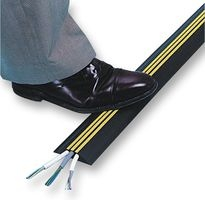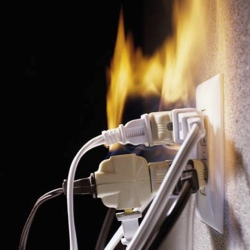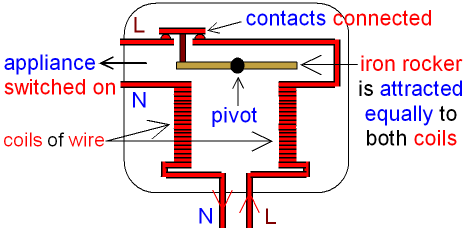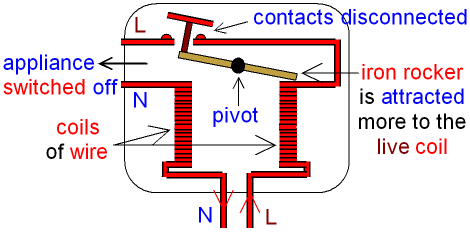Electric Faults in appliances or circuits can cause fires and electric shocks.
This can be caused due to three reasons: Damaged insulation, overheating of cables and damp conditions.

A lot of mains powered appliances need three wires to work safely. Only two of the wires are used when the appliance works properly. These are the live (brown) and the neutral (blue) wires. The live wire carries current to the appliance at a high voltage. The neutral wire completes the circuit and carries current away from the appliance. The third wire, called the earth wire (green/yellow) is a safety wire and connects the metal case of the appliance to the earth. This stops a fault making the case of the appliance live.

If a fault occurs where the live wire connects to the case, the earth wire allows a large current to flow through the live and earth wires. This overheats the fuse which melts and breaks the circuit.
Appliances such as hairdryers are said to be 'double insulated' and there's no need for an earth wire because the case is made of a non conducting plastic. If a faulty live wire touches the inside of the plastic case there's little risk as the case is an insulator.
Damaged Insulation

Insulation means putting something which does not conduct electricity (an insulator)
between a live conductor and yourself. The wires which we use to conduct electricity
are made of a high purity copper metal, which is an excellent conductor.
The insulator which covers the wires is a polymer called PVC (often just called "plastic"). It is an excellent insulator, flexible enough to bend around corners and cheap to make. Older wires had a rubber material as their insulation but the rubber becomes damaged due to wear and tear as it got older and so it has been replaced in houses by new PVC covered cable. If not replaced, this might cause the electrical insulation to break and crack.
Insulation can become unsafe if it is damaged or if it is wet because impure water will conduct electricity.The exposed live wire can cause severe electric shock to the user if it is touched. This can lead to serious injury or even death.
Overheating of cables

Plugging too many power cables into a socket can result in the socket being overloaded, overheating, and a fire starting as an unusually large current flows through the conducting wires.
Each wire in a power has a specific resistance depending on the specific thickness of the wires. The combined higher resistance of all wires will produce a more thermal heat that will damage the insulation and may cause a fire.
Solution: Never plug too many cables into a socket. Always make sure there are fire extinguishers nearby. Don’t use thin cable to carry large current.
Damp Conditions
Water or damp conditions allow current to flow outside the wires – keep electrics dry. It allows a conducting path for a large current to flow. A person could be electrocuted if the wires were exposed or had damaged insulation.
Other hazards include turning a switch on with wet hands.
Safe use of Electricity at home
Mains electricity is safe to use if we avoid touching a Live conductor,
and the current is kept down to a safe level.
Safety measures include :
Insulation
Double Insulation
Earthing
Fuses
Circuit Breakers
Circuit Breakers

The circuit breaker acts as a safety device in the same way as a fuse.
It disconnects the supply if too large a current flows.
When the live wire carries the usual operating current the electromagnet is not strong enough to separate the contacts. If something goes wrong with the appliance and a large current flows the electromagnet will pull hard enough to separate the contacts and break the circuit. The spring then keeps the contacts apart.
After the fault is repaired, the contacts can then be pushed back together
by pressing a button on the outside of the circuit breaker box.
Residual Current Circuit Breaker - RCCB or Earth Leakage Circuit Breaker - ELCB
This type of circuit breaker works by comparing
the current going in to an appliance with the current coming out.
When an appliance is working correctly
all of the current entering the appliance through the live wire
is returned to the power supply through the neutral wire.
In the picture below the strength of the magnetic field
is the same in both coils because they both have the same current.

If something goes wrong with the appliance some of the electric current will flow through the earth wire. The amount of current flowing through the neutral wire decreases and now there is a difference between the current entering the appliance through the live wire and the current returned to the power supply through the neutral wire. This difference is called the residual current.
The coil connected to the neutral wire now has a weaker magnetic field than the coil connected to the live wire. The iron rocker turns about the pivot and the contacts are disconnected which switches off the appliance and makes it safe.
See the picture below.

Fuse

The fuse has a thin piece of wire inside it, which is the weakest link in a circuit.
A fuse is a safety device which switches off an appliance if too large a current flows through the Live wire. The fuse is connected between the Live pin and the Live wire of a plug.
The fuse has a rating printed on the outside in amps. If the current going through the fuse rises above its rated value, then the fuse "blows" (it melts) which turns off the appliance.This is so that the appliance will not become charged after the fuse has melted due to an overflow of current.
For example, if the fuse says 5 amps, then a current greater than 5 amps will blow the fuse.
Fuses are given different colours for different ratings.This is called colour coding.
A 2 amp fuse is blue,
3 amp is red,
5 amp is black (or very dark blue),
13 amp is brown.
A fuse has its own circuit symbol.
Most plugs come with a 13 amp fuse but a smaller fuse is needed for many appliances. This is how to do it:
1 . Look at the power rating (wattage) printed on the appliance.
2 . Divide the power (in watts) by 240 (house voltage).
3 . Before you change a fuse, always switch off the mains power supply.
The result is the current (amps) needed by the appliance. (Amps = watts ÷ volts)
Then choose a fuse with a slightly higher current rating.
For example, if your toaster says 1000 watts, the current it uses is: 1000 W ÷ 240 V = 4.2 A
So you would use a 5 A fuse.
Earthing
If the outer casing (the outside bit) of an appliance is a conductor (made of metal), then it can be made safe by Earthing. The Earth wire usually carries no electricity, it is connected to the metal case on the inside of the appliance.

If something goes wrong inside the appliance and the Live wire touches the metal case, then the Earth wire acts like a Neutral wire and completes the circuit for the electricity.
A very large current suddenly flows because the metal case has little resistance.
This large current blows the fuse in the plug and disconnects the appliance from the power supply.
Double Insulation.
Some appliances are double insulated. These appliances only need Live and Neutral wires, they do not need an Earth wire.
An appliance which is double insulated has the whole of the inside contained in plastic, underneath an outer casing. If anything goes wrong with the appliance,
no Live conductor can touch the outer casing because of the insulating plastic.

Appliances which are double insulated include electric drills and hairdryers.
The symbol for double insulation is shown below.

You will see this symbol printed on the appliance which is double insulated.
thank you! very useful <3
ReplyDeleteamazingly useful! thank you so much!
ReplyDelete